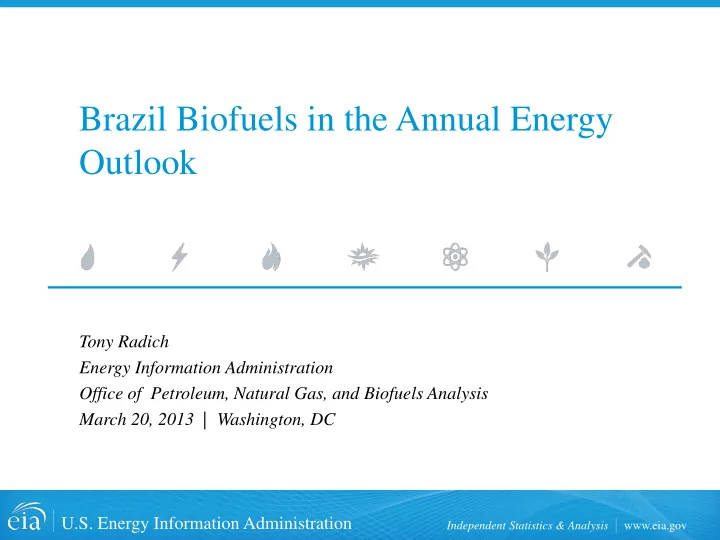

Brazil Biofuels in the Annual Energy Outlook Tony Radich Energy Information Administration Office of Petroleum, Natural Gas, and Biofuels Analysis March 20, 2013 | Washington, DC U.S. Energy Information Administration Independent Statistics & Analysis www.eia.gov
Presentation Outline • RFS Advanced Biofuels Standard • Data on Brazil ethanol imports and exports • Brazil ethanol supply model • Directions that Brazil trade might take in the future Tony Radich, Biofuels Projections in 2 the AEO, March 20, 2013
Sugarcane and cellulosic ethanol are favored by the RFS2 and LCFS but must compete with corn ethanol for blending capacity. Fuel: Corn ethanol • Currently, most ethanol blended is (inexpensive) corn ethanol • Counts as Conventional biofuel Fuel: Sugarcane ethanol (mainly from Brazil) • Not cellulosic, but does count as an RFS Advanced biofuel • Competes for limited ethanol blending capacity Fuel: Biomass-based diesel • Not cellulosic, but does count as an RFS Advanced biofuel Fuel: Cellulosic biofuels • Ethanol or drop-in fuel • If ethanol, must compete for limited ethanol blending capacity • Production of biochemicals or electricity may displace cellulosic biofuel production Tony Radich, Biofuels Projections in 3 the AEO, March 20, 2013
The requirement for unspecified advanced biofuels has so far been larger than the RFS2 legislation indicates. Billion ethanol gallon equivalents 4 3.5 Advanced Biofuel 3 Standard As Legislated 2.5 Unspecified Advanced 2 Biofuel Standard as Legislated 1.5 Unspecified Advanced 1 Biofuels as Implemented 0.5 0 2011 2012 2013 2014 Source: U.S. Environmental Protection Agency Tony Radich, Biofuels Projections in 4 the AEO, March 20, 2013
The U.S. exported corn ethanol to Brazil to supplement tight supplies of sugarcane ethanol while importing sugarcane ethanol to help meet the RFS2 and the LCFS. Million gallons 80 60 Exports to Brazil Imports from Brazil 40 20 0 -20 -40 -60 -80 2010 2011 2012 Source: EIA Monthly Import Survey and U.S. Bureau of the Census Tony Radich, Biofuels Projections in 5 the AEO, March 20, 2013
EIA model of supply of Brazil ethanol to U.S. • Residual supply approach – The quantity available to the U.S. is the remainder of Brazil’s production after Brazil’s domestic ethanol demand and rest -of-world export demand is satisfied – “Rest -of- world” is defined as all nations other than Brazil and the U.S. • If the U.S. bids a higher price – Production increases – Brazil consumption and rest-of-world demand for ethanol imports from Brazil both decline – Result is a larger quantity available to the U.S. • If the U.S. bids a lower price – Production decreases – Brazil consumption and rest-of-world demand for ethanol imports from Brazil both increase – Result is a smaller quantity available to the U.S. Tony Radich, Biofuels Projections in 6 the AEO, March 20, 2013
Imported ethanol is expected to play more of a role than cellulosic ethanol in meeting the Advanced Biofuels requirement. Consumption of Advanced biofuels Billion gallons ethanol equivalent 12.5 10 Other Advanced 7.5 BTL-Pyrolysis Renewable Diesel 5 Biodiesel Imported Ethanol Cellulosic Ethanol 2.5 0 2011 2015 2019 2023 2027 2031 2035 2039 Source: Annual Energy Outlook 2013 Early Release Tony Radich, Biofuels Projections in 7 the AEO, March 20, 2013
An arbitrage scenario for physical two-way ethanol trade between the U.S. and Brazil. • U.S. obligated parties prefer sugarcane ethanol over corn ethanol. – Sugarcane ethanol counts toward the RFS advanced requirement. – This preference is reflected in the prices of the physical biofuels and in the prices of the respective RINs. • Brazil users are (presumably) indifferent to corn ethanol versus sugarcane ethanol for its own domestic consumption (approx. 6 billion gallons per year). – Are Brazil producers/owners also indifferent? • Individual parties or the market as a whole may be able to swap physical U.S. corn ethanol with physical Brazil sugarcane ethanol. – U.S. swapped 101 million gallons in 2010 and 86 million gallons in 2011. – U.S. was a net exporter to Brazil in 2011 and a net importer from Brazil in 2012. – Could this be profitably scaled up by an order of magnitude or two? Tony Radich, Biofuels Projections in 8 the AEO, March 20, 2013
Other advanced biofuels from Brazil? • Previous Annual Energy Outlook modeling assumed that Brazil would become a major producer of cellulosic ethanol – Fibrous material known as bagasse is left after sugar is extracted from cane and can be used to produce ethanol – Brazil technology developers have run into similar technical problems as North American and European developers – Ethanol from bagasse has an opportunity cost - could instead be used to generate electricity • Brazil has introduced biodiesel to its liquid fuels supply – 5 percent blend requirement since 2010 – 10 percent requirement proposed for 2020 – Not enough production capacity to export and still meet domestic requirements Tony Radich, Biofuels Projections in 9 the AEO, March 20, 2013
For more information U.S. Energy Information Administration home page | www.eia.gov Short-Term Energy Outlook | www.eia.gov/steo Annual Energy Outlook | www.eia.gov/aeo International Energy Outlook | www.eia.gov/ieo Monthly Energy Review | www.eia.gov/mer EIA Information Center (202) 586-8800 InfoCtr@eia.gov 24-hour automated information line about EIA Our average response time is within three and frequently asked questions. business days. Tony Radich, Biofuels Projections in 10 the AEO, March 20, 2013
Recommend
More recommend